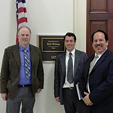Legislation & Regulation
Legislative and Regulatory Update
September 2019 by Scott Harn
• ESA changes for the better
On August 12, 2019, the Trump administration finalized three rules governing the Endangered Species Act (ESA). (They are rather lengthy documents and links are provided at the end of this article.)
These rules are major improvements and will:
- Advise the public of the economic impact of a listing decision.
- Limit circumstances where unoccupied habitat can be designated as critical habitat.
- Remove the “blanket rule” that applied all prohibitions regarding endangered species to threatened species.
- Shift the burden to the Fish & Wildlife Service to define prohibitions for threatened species on a case-by-case basis subject to the rulemaking process.
- Provide a new definition for threatened species that will limit the scope of threats weighed in the listing decision to those which are probable in the foreseeable future.
- Streamline the de-listing process to removed recovered species from the list.
Clark Pearson (Public Lands for the People) and I had two in-person meetings with officials in the current administration in DC regarding these issues, and we are happy to see these specific items being addressed.
Further justification for the rulemaking comes from a unanimous decision by the US Supreme Court in Weyerhaeuser v. US Fish & Wildlife. In this 2018 case, the court ruled that the ESA must consider economic and other impacts before making a critical habitat designation.
In Weyerhaeuser, the Fish & Wildlife Service designated a parcel of land in Louisiana critical habitat for the endangered dusky gopher frog. The frog currently lives hundreds of miles away in Mississippi and had not been seen in Louisiana for decades. Additionally, the land in question was deemed unsuitable for the frog, but the Service claimed that habitat can include areas that would require “some degree of modification.” The US Supreme Court disagreed.
_______________
Fish & Wildlife: Endangered and Threatened Species Interagency Cooperation: https://www.federalregister.gov/documents/2019/08/27/2019-17517/endangered-and-threatened-wildlife-and-plants-regulations-for-interagency-cooperation
Fish & Wildlife: Listing Species and Designation Critical Habitat: https://www.federalregister.gov/documents/2019/08/27/2019-17518/endangered-and-threatened-wildlife-and-plants-regulations-for-listing-species-and-designating
Fish & Wildlife: Prohibitions to Threatened Wildlife and Plants: https://www.federalregister.gov/documents/2019/08/27/2019-17518/endangered-and-threatened-wildlife-and-plants-regulations-for-listing-species-and-designating

California Suction Dredging Update
Another California Assembly member, Jared Huffman, is attempting to ban dredging in the state on a more permanent basis.
Legislative and Regulatory Update
• California suction dredgers had better prepare for battle
Proof Mining Districts Work!
 If you need more proof that having an organized Mining District can help you, look no further than the recently proposed Methow Headwaters Withdrawal in north-central Washington State.
If you need more proof that having an organized Mining District can help you, look no further than the recently proposed Methow Headwaters Withdrawal in north-central Washington State.
Legislative and Regulatory Update
- Zinke leaving office
- Property rights triumph over critical habitat says Supreme Court
- Water of the United States
PLP and MMAC Update
Minerals and Mining Advisory Council (MMAC) founder Joe Martori met with Jim Scrivner, the Bureau of Land Management Deputy State Director of Energy and Minerals in Sacramento, California...
Fighting and Winning Without a Lawyer
This article may not be as interesting as someone describing a big nugget find in Australia...but right now the biggest obstacle to mining is our government.
Subscription Required:
The Bawl Mill
• Ask The Experts - How do I remove the silvery-white coating from my gold?
• Ask The Experts - Is it possible to mine glacial moraine placer deposits?
• Ask The Experts - Why are some valid mining claims missing from apps when researching land status?
• Ask The Experts - Is using a drywasher legal in California
• A High Country Patch
• An Update On The Father's Day Gold Discovery
• Exploring The Historic Rand Mining District, Southern California
• Disturbing Trend: Federal Judges Disregard Mining Laws
• My First Carolina Nugget
• How to Refine Silver—Pt I
• Step-by-Step Crevicing
• Melman on Gold & Silver
• Mom Finds 3.72-Carat Yellow Diamond
• Mining Stock Quotes and Mineral & Metal Prices
Free:
PLP Update: How to Restore The Rights of Suction Dredge Miners









